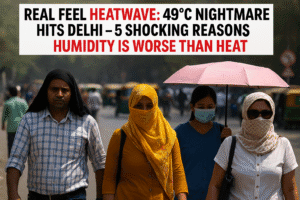Real Feel Heatwave: 49°C Nightmare Hits Delhi – 5 Shocking Reasons Humidity Is Worse Than Heat
Delhi is enduring brutal summer-like heat despite the monsoon’s arrival, with humidity amplifying the real-feel temperature to a scorching 48.9°C—far hotter than the recorded 36.9°C maximum. High humidity (59-89%) and a dangerous wet-bulb temperature of 29.57°C made conditions unbearable, pushing the body’s cooling mechanism to its limits. The monsoon, which arrived two days late, has brought little relief, with only 3.8mm of rain in early July against a normal 209.7mm. While light showers are expected this weekend, experts warn relief will be patchy, leaving residents trapped in stifling heat.
The oppressive weather raises health risks, particularly for outdoor workers, and strains power demand as people rely heavily on cooling appliances. Delhi’s air quality remains “satisfactory” (AQI 72), but humidity could worsen pollution retention. This extreme humid heat underscores a growing climate challenge—monsoon delays and rising humidity are making urban summers increasingly hazardous. Authorities must prioritize heat resilience measures as such conditions may become more frequent.

While Delhi officially entered monsoon season on June 29, residents faced a cruel irony on Thursday as soaring humidity pushed the real-feel temperature to a blistering 48.9°C—making it feel more like peak summer than the anticipated rainy respite.
The Science Behind the Suffering
The India Meteorological Department (IMD) recorded a maximum temperature of 36.9°C (slightly below normal), but humidity levels between 59% and 89% created oppressive conditions. The key metrics explaining the discomfort:
- Wet-Bulb Temperature: Reached 29.57°C—dangerously close to the 32°C threshold where the human body struggles to cool itself.
- Heat Index (Real Feel): The combination of heat and humidity made it feel nearly 12°C hotter than the actual temperature.
This phenomenon occurs because high humidity slows sweat evaporation, the body’s natural cooling mechanism. For outdoor workers, commuters, and vulnerable groups, this poses severe health risks, including heat exhaustion and heatstroke.
Monsoon’s Delayed Relief
Despite IMD’s monsoon declaration, Delhi has seen only 3.8mm of rain in July—far below the monthly average of 209.7mm. The monsoon trough, currently south of Delhi, is expected to shift northward by Saturday (July 5), bringing scattered showers. However, experts caution:
- Skymet Weather predicts “marginal” rain improvement this weekend.
- Independent forecasters warn of “localized intense showers” but no widespread relief until at least July 9.
Health and Environmental Impacts
- Heat Stress: Prolonged exposure to high wet-bulb temperatures can be fatal, especially for laborers and homeless populations.
- Air Quality: AQI remained “satisfactory” (72), but increased humidity can trap pollutants, worsening respiratory conditions.
- Power Demand: Surged as residents relied heavily on air conditioning and coolers.
What’s Next?
- Friday (July 5): Similar conditions with highs around 37°C and humidity over 60%.
- Weekend: Light to moderate rain likely, but sporadic. A yellow alert is in place for Saturday.
- Long-Term: Experts urge preparedness for erratic monsoon patterns, linking them to climate change-driven shifts in weather systems.
Why This Matters Beyond Delhi
Delhi’s struggle highlights a growing global trend: humid heatwaves are becoming deadlier than dry ones. Cities must adapt urban planning (green spaces, heat-reflective infrastructure) and public health protocols to protect residents.
For now, Delhiites must brace for more “feels-like” 45°C+ days—a stark reminder that monsoon onset doesn’t always mean cooler weather.
You must be logged in to post a comment.